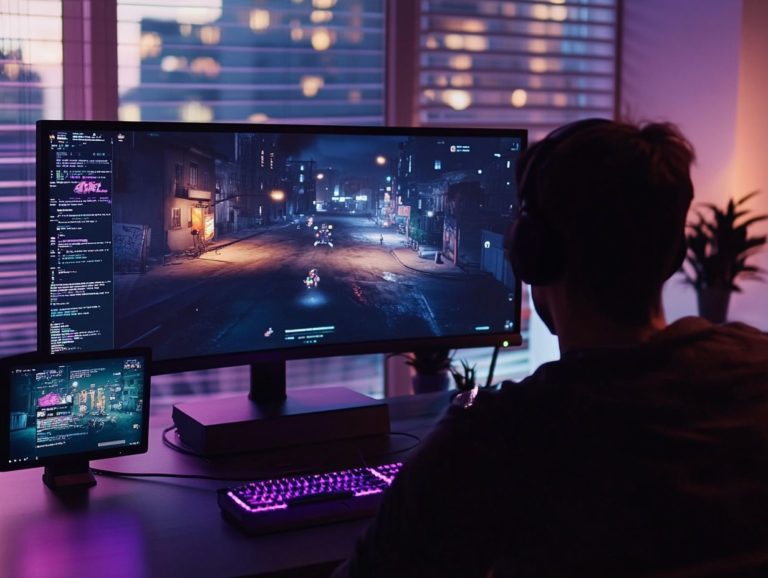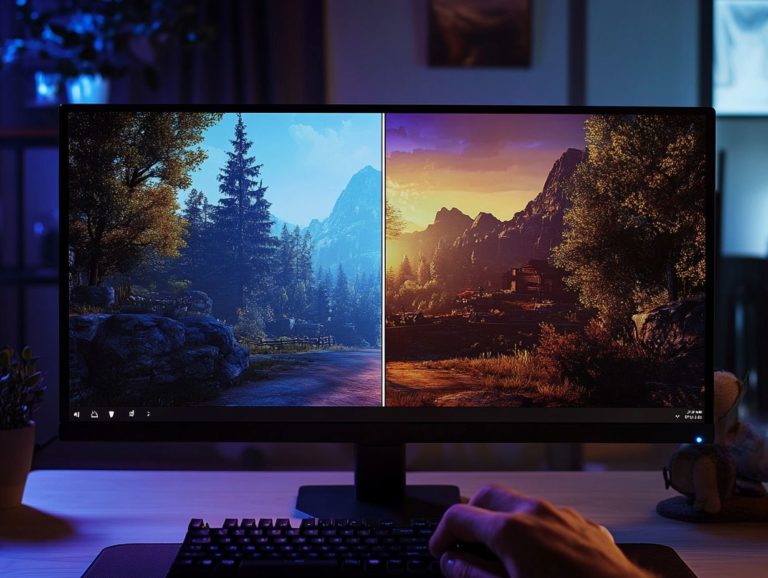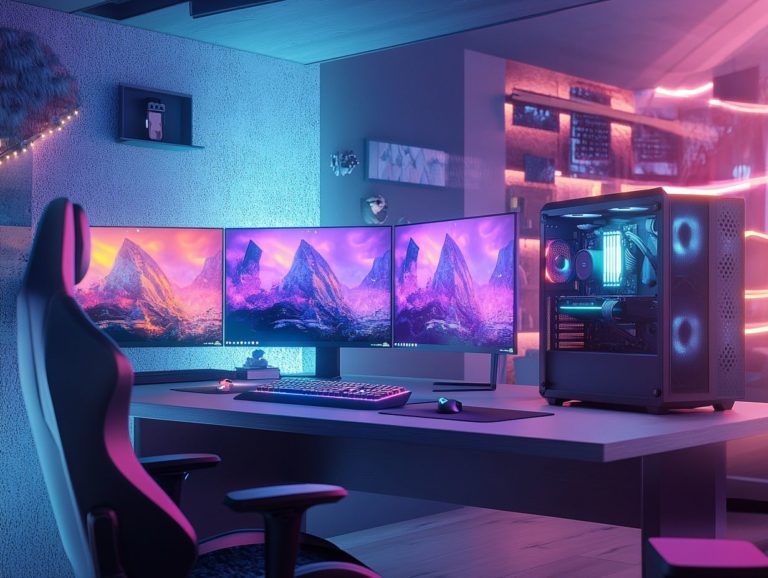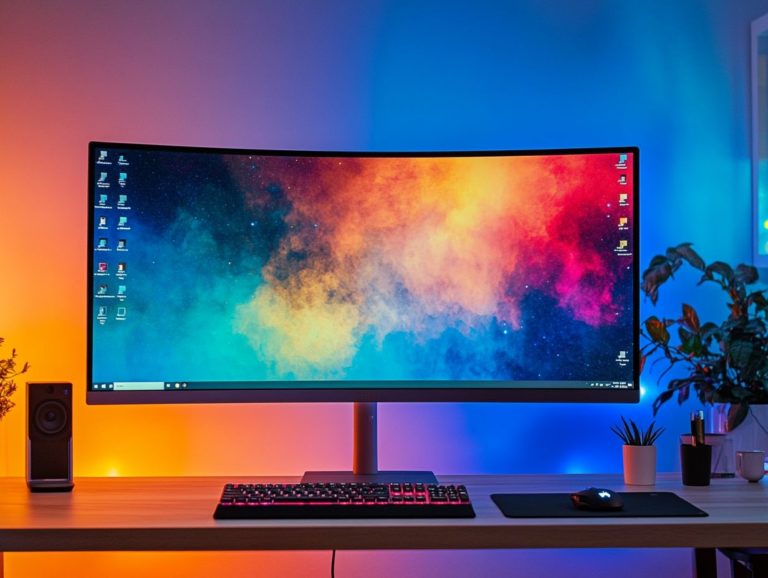5 must-have features in gaming monitors
Choosing the right gaming monitor can elevate your gaming experience from ordinary to extraordinary.
With so many options available, understanding the key features is essential. Here are five must-have features every gamer should consider:
- High refresh rates for smooth gameplay
- Low input lag for quick responsiveness
- High resolution for stunning visuals
- Adaptive sync technology to eliminate screen tearing
- A wide color gamut for rich, vibrant colors
You will also learn what a gaming monitor is, the types available, how these features affect performance, and what to consider when making your choice.
Get ready to transform your gaming setup into something remarkable!
Contents
- Key Takeaways:
- 1. High Refresh Rate for Smooth Gameplay
- 2. Low Input Lag for Fast Response Time
- 3. High Resolution for Crisp and Clear Graphics
- 4. Adaptive Sync Technology for Tear-Free Gaming
- 5. Wide Color Gamut for Vibrant and Accurate Colors
- What Is a Gaming Monitor and Why Is It Important?
- Frequently Asked Questions
- 5 Must-Have Features for Gaming Monitors!
- Why is a high refresh rate important in a gaming monitor?
- What is considered a low response time in a gaming monitor?
- What is adaptive sync technology and why is it important for gaming monitors?
- Is a high resolution necessary for gaming monitors?
- What is a wide color gamut and why is it important in gaming monitors?
Key Takeaways:
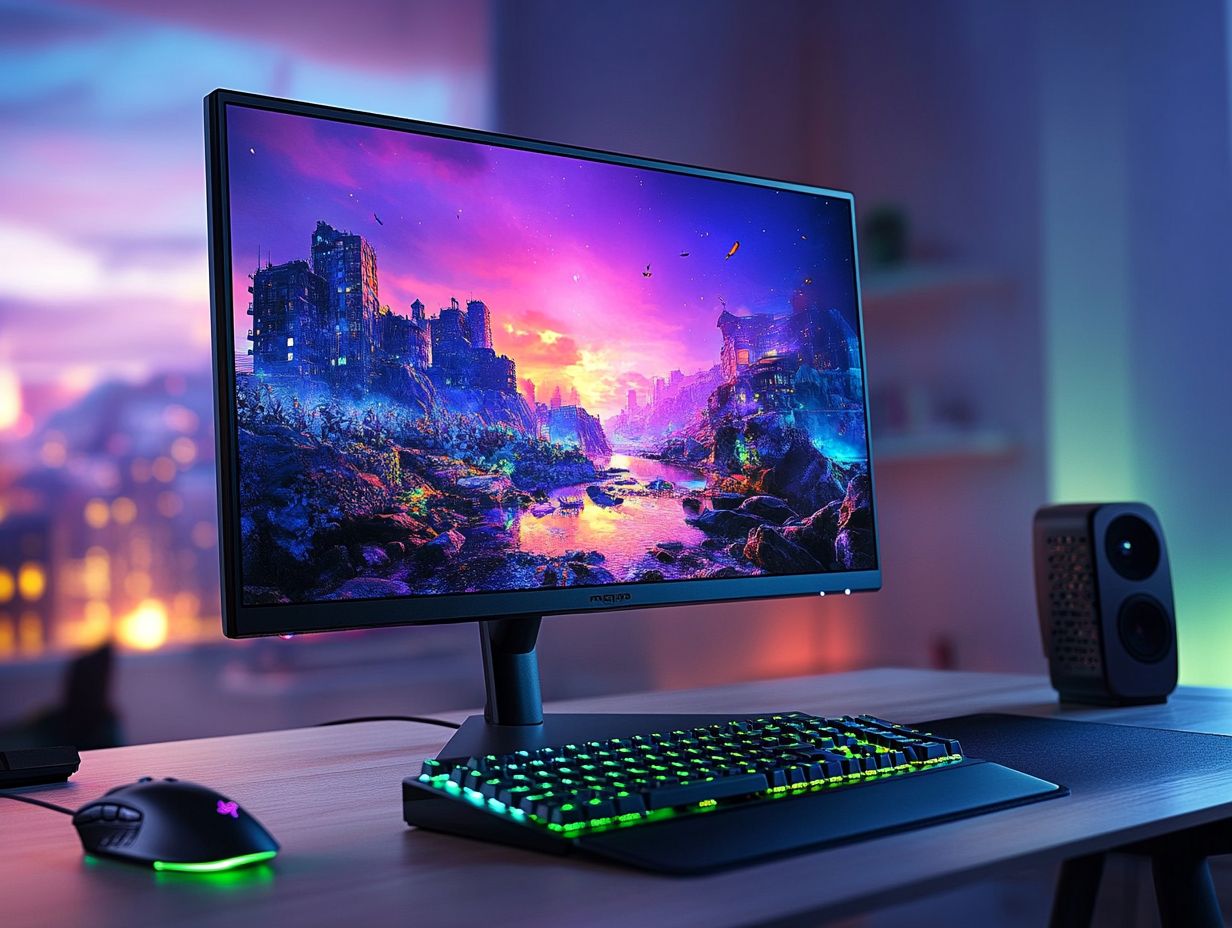
A high refresh rate ensures smooth gameplay, reducing motion blur and providing an immersive experience.
Low input lag means faster response time, crucial for competitive gaming.
High resolution displays offer crisp graphics, enhancing visual quality and detail.
1. High Refresh Rate for Smooth Gameplay
A high refresh rate is key for smooth gameplay. It minimizes motion blur and allows you to enjoy fluid motion in your favorite games.
This is especially important in fast-paced games, where quick reactions can mean the difference between winning and losing. A 144Hz monitor offers a noticeable improvement over a standard 60Hz monitor.
With a high refresh rate display, you can track moving objects with greater precision. Monitors like the ASUS ROG Swift PG259QN and Acer Predator X25 exemplify these benefits.
Choosing a high-refresh-rate monitor enhances your performance and makes your gaming journey more visually engaging.
2. Low Input Lag for Fast Response Time
Low input lag is vital for fast response times. It greatly affects your gaming performance, especially in competitive situations.
Even a slight delay can shift the outcome of a game. You need immediate feedback to execute your strategies effectively.
When comparing TN (Twisted Nematic) panels to IPS (In-Plane Switching) panels, TN displays typically offer lower input lag. While they excel in speed, IPS panels provide better color accuracy and viewing angles.
Understanding these differences helps you make informed decisions based on your gaming style.
3. High Resolution for Crisp and Clear Graphics
High resolution is crucial for an exceptional gaming experience. It delivers clear graphics that enhance the visual clarity of your games.
Whether you re playing at 1080p, 1440p, or even 4K, the difference in detail is significant. For example, the Dell S2721D monitor offers sharper textures compared to standard 1080p displays.
If you choose a 4K monitor like the ASUS ROG Swift PG32UQ, you ll enjoy remarkable clarity. This helps you spot enemies or immerse yourself in stunning landscapes.
Higher resolutions not only provide beautiful visuals but also deepen your emotional connection to the game.
4. Adaptive Sync Technology for Tear-Free Gaming
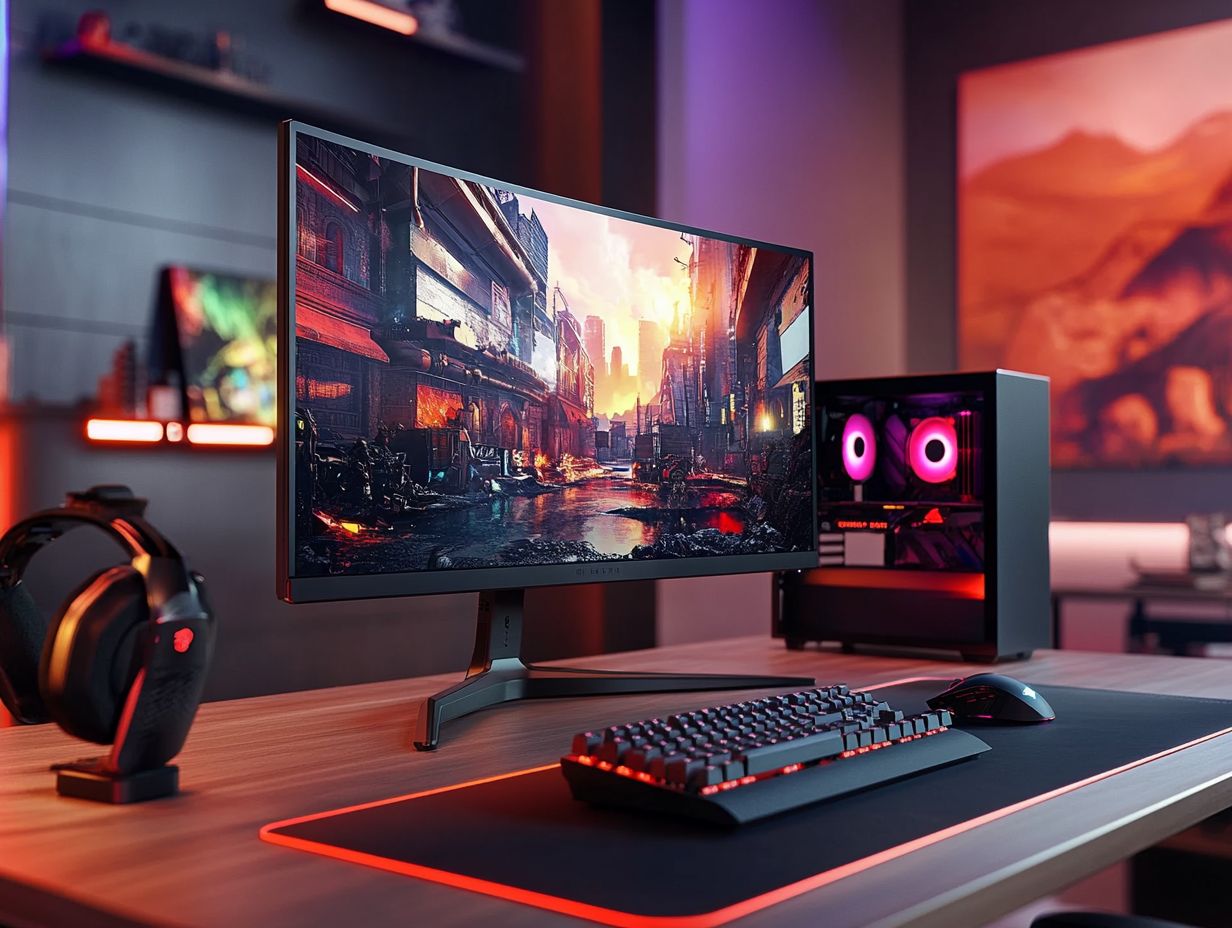
Adaptive Sync technology, such as FreeSync and G-Sync, is essential for achieving a tear-free gaming experience. It synchronizes the refresh rate of your monitor with the frames generated by your graphics card.
This synchronization effectively eliminates screen tearing, which can disrupt your immersion during fast-paced action scenes.
FreeSync, developed by AMD, uses an open standard that allows a wider range of monitors like the ASUS VG258QM and Acer XFA240 to support adaptive refresh rates. G-Sync, designed by NVIDIA, requires proprietary hardware, typically found in high-end monitors like the Acer Predator X27 and ASUS ROG Swift PG259QN.
These technologies maintain frame integrity and enhance overall gameplay fluidity, making them vital for serious gamers seeking an edge in competitive settings.
5. Wide Color Gamut for Vibrant and Accurate Colors
A wide color gamut is crucial for vibrant and accurate colors, enhancing your gaming experience by reproducing a broader spectrum of hues. This is particularly true for HDR monitors that improve color depth and deliver lifelike visuals.
High-performance monitors like the Dell Alienware AW2521H and ASUS ROG Swift PG32UQ are renowned for their exceptional color accuracy and dynamic range, making them some of the top 5 immersive gaming monitors available.
These displays utilize advanced technologies that reveal subtle nuances in every scene, whether you re exploring vibrant landscapes or battling in dark dungeons.
Such enhancements sharpen details and ensure that every pixel is a visual delight, resulting in an immersive gaming atmosphere that keeps you engaged.
What Is a Gaming Monitor and Why Is It Important?
A gaming monitor is not just any display; it’s a specialized powerhouse designed to enhance your gaming PC’s performance. With crucial features that improve visual clarity, understanding what are the essential features of a gaming monitor becomes essential for those who seek top-notch display technology and immersive gameplay.
These monitors boast impressive specifications, including higher refresh rates and reduced response times. Understanding what features a gaming monitor should have dramatically improves how smoothly your games run and how quickly on-screen actions respond to your commands.
A 144Hz refresh rate transforms fast-paced action sequences into a seamless experience, minimizing motion blur and keeping you fully engaged.
With adaptive sync technology, screen tearing is a thing of the past. Every gaming session becomes about relishing vibrant visuals and captivating gameplay. These advancements take your experience to the next level!
What Are the Different Types of Gaming Monitors?
When exploring gaming monitors, you’ll find several types to choose from:
- TN Panels: Offer incredibly fast response times, ideal for high-octane action games, but may lack in color accuracy and viewing angles.
- IPS Panels: Excel in color reproduction and provide wider viewing angles, perfect for visually stunning games, though they might lag in speed.
- OLED Displays: Shine with deep blacks and vibrant colors, but often come with a higher price tag and potential burn-in concerns.
- Ultrawide Monitors: Significantly enhance immersion, making them perfect for both single-player journeys and competitive gaming.
Choose according to your preferences and gaming style to find the perfect fit!
How Do These Features Affect Gaming Performance?
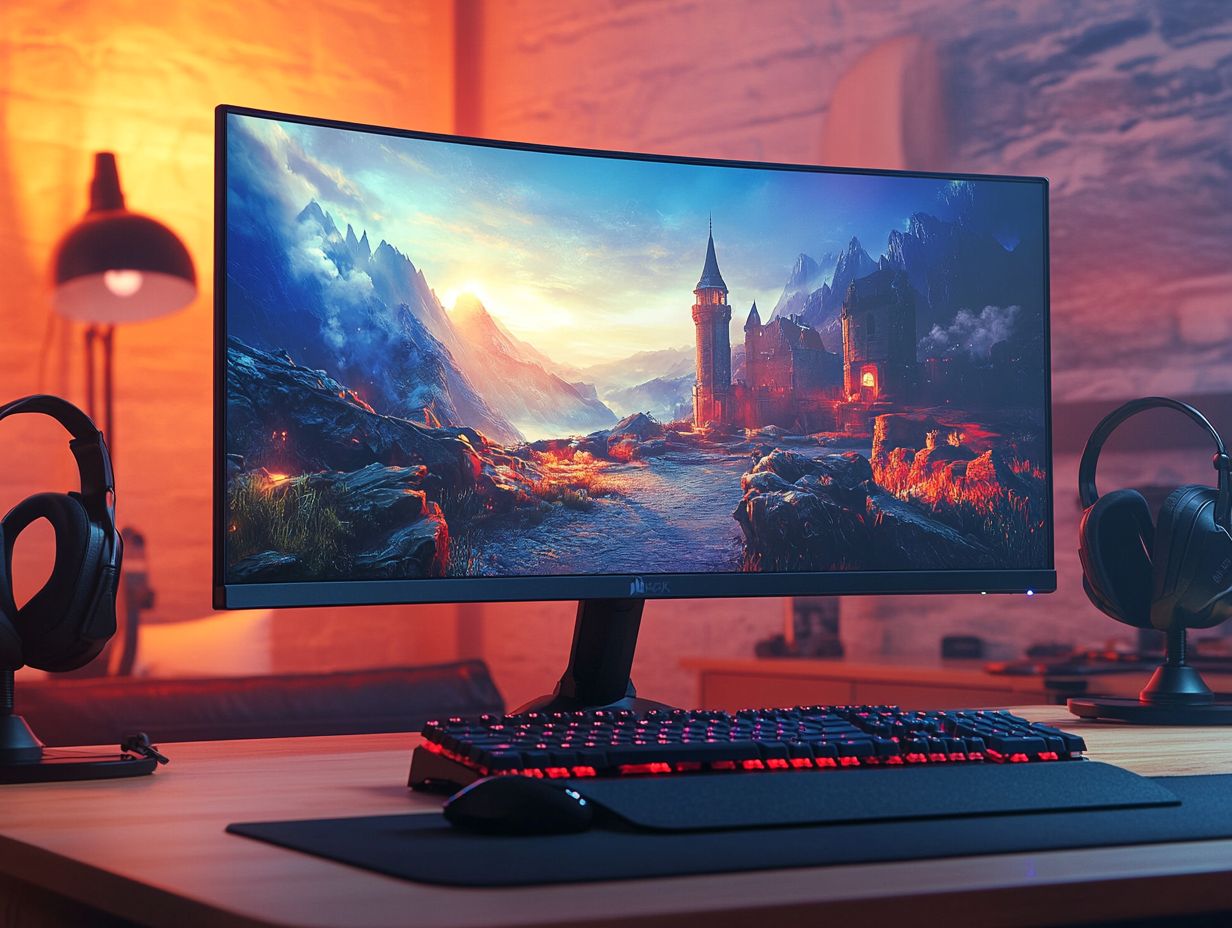
The features of gaming monitors, such as refresh rate, response time, adaptive sync technology, and color gamut, significantly influence gaming performance. For an in-depth look, check out the top features to look for in gaming monitors. These elements ensure smooth gameplay, rich colors, and minimal lag, delivering a superior visual experience.
A higher refresh rate grants smoother motion, reducing blur during intense action scenes and giving you a competitive edge in fast-paced games. An improved response time minimizes ghosting, allowing every move to be reflected on-screen instantly.
Adaptive sync technology helps match the display’s refresh rate with the graphics card’s output to avoid tearing, creating an uninterrupted visual flow that immerses you in the game world. A wider color gamut offers vibrant hues and deeper blacks, working together to craft an engaging visual narrative.
This synergy enhances your immersion, making you feel truly part of the action.
What Are the Other Factors to Consider When Choosing a Gaming Monitor?
When hunting for a gaming monitor, it’s essential to weigh factors beyond resolution and refresh rate. Consider display size, pixel density, and HDMI 2.1 compatibility, which are vital for optimizing your gaming setup. You might also explore the 5 reasons to upgrade your gaming monitor for more insights.
Your personal preferences will also influence your decision. You might prefer screen curvature or panel type, as these choices can dramatically change your gaming experience.
The size of your room is critical; if you re in a compact space, a smaller monitor with high pixel density could be ideal, while larger rooms can handle bigger displays for a more immersive experience.
Budget constraints will complicate your choices, as they determine the quality and features that fit within your financial plan. Striking a balance among these elements will help you discover a monitor that genuinely elevates your gaming experience, especially when considering the top 5 monitors for competitive gaming.
What Are the Benefits of Investing in a High-Quality Gaming Monitor?
Investing in a high-quality gaming monitor offers a wealth of benefits, from enhanced visual clarity to improved performance. It transforms your gaming experience, making a noticeable difference in how you engage with your favorite titles.
A monitor with exceptional color accuracy brings every shade to life, immersing you deeper into the gameplay. In competitive settings, reduced lag times are crucial; those split-second reactions can mean the difference between victory and defeat, making modern gaming controllers with the right features essential for any gamer.
An upgraded refresh rate enhances graphics, ensuring fast-paced scenes flow seamlessly without blurring. These features not only elevate the visual appeal of gaming but also create an environment that maximizes responsiveness and precision, resulting in a captivating experience that keeps you on the edge of your seat.
How Can a Gaming Monitor Enhance the Gaming Experience?
A gaming monitor can elevate your gaming experience through advanced display technology that works seamlessly with your graphics card. For those interested in virtual reality, checking out the top 5 monitors for virtual reality gaming can help ensure you enjoy stunning graphics and fluid gameplay that keeps you engaged.
Features like high refresh rates, vibrant color accuracy, and low response times are essential.
For fast-paced action games like “Call of Duty,” playing on a monitor with a refresh rate of 144Hz or higher is rewarding, significantly reducing motion blur and providing crisp visuals during intense gunfights.
Titles like “The Witcher 3” shine on monitors equipped with HDR capabilities, allowing lush environments and intricate details to pop, creating a captivating experience.
By merging resolution with these advanced features, you ll find yourself deeply immersed in rich storylines and dynamic worlds like never before.
Frequently Asked Questions
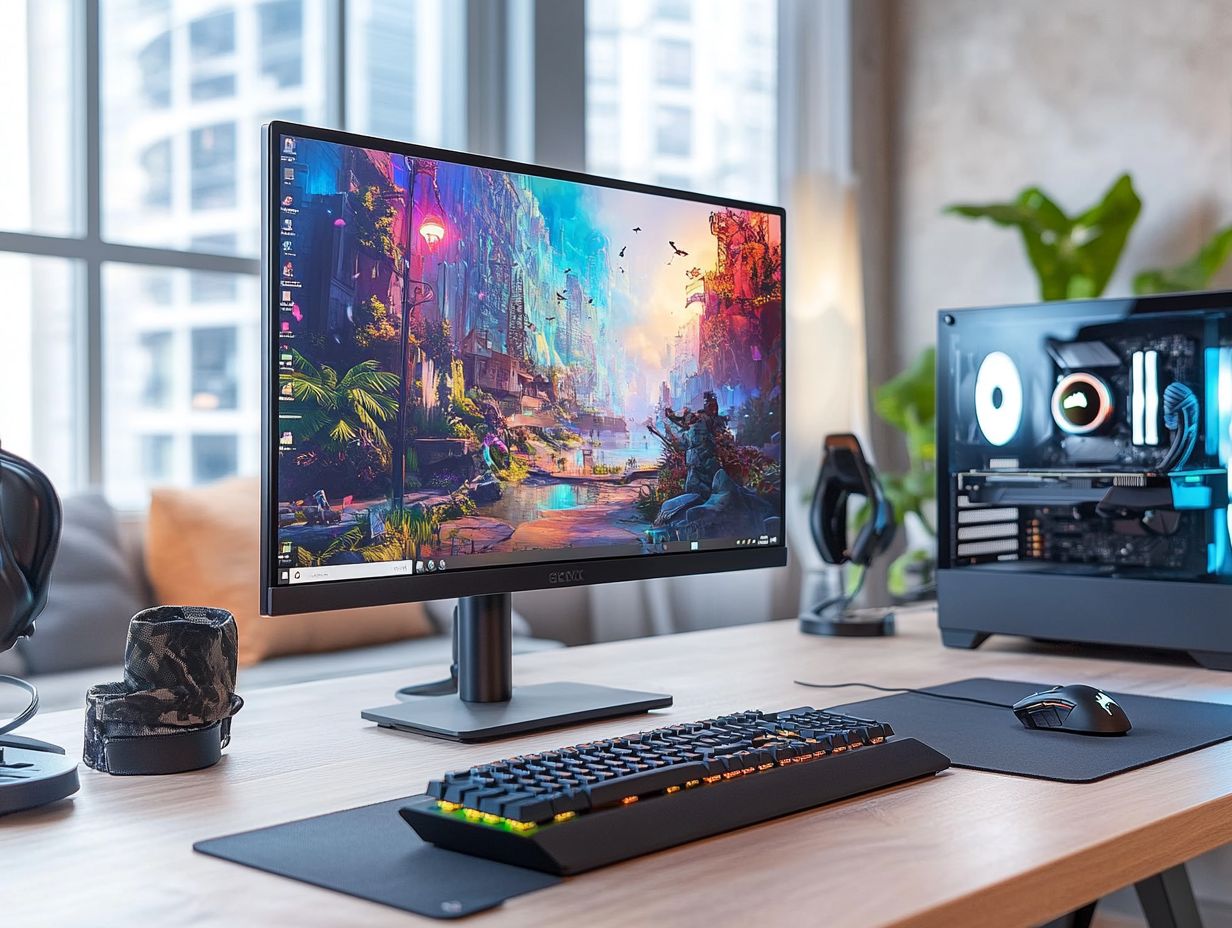
5 Must-Have Features for Gaming Monitors!
These five features transform your gaming experience. Let s dive into why they matter!
Why is a high refresh rate important in a gaming monitor?
A high refresh rate, usually 144Hz or higher, allows for a smoother and more responsive gameplay experience. This lets the monitor show up to 144 frames per second, resulting in less motion blur and a more fluid gaming experience.
What is considered a low response time in a gaming monitor?
A low response time refers to the time it takes for a monitor to change from one color to another, usually measured in milliseconds (ms). A response time of 1ms is ideal. It minimizes motion blur and ghosting.
What is adaptive sync technology and why is it important for gaming monitors?
Adaptive sync matches your monitor’s refresh rate with the graphics card. This keeps your gameplay smooth and free from screen tearing, enhancing your overall visual experience.
Is a high resolution necessary for gaming monitors?
A high resolution like 4K gives you clearer images. But remember, you may need a powerful graphics card to keep up with the demanding visuals.
What is a wide color gamut and why is it important in gaming monitors?
A wide color gamut shows more colors on your screen. This makes games look vibrant and realistic, especially in rich graphics like RPGs or first-person shooters.

